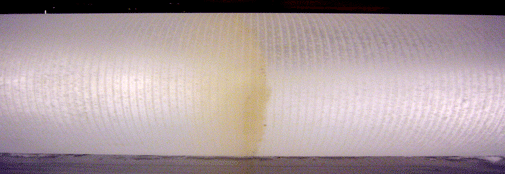Greetings from Iceland

The Z2 ash layer in the ice core. Note: The picture has been stretched horizontally to
double length to fit the frame. The picture yesterday was taken with a camera suspended from a kite at 200 m altitude. We use this kite for meteorological measurements.
Not many weeks ago the volcano Eyjafjallajökull erupted in Iceland, disrupting air traffic, even here at NEEM. This eruption, however dramatic to behold, is small in the annals of Icelandic volcanic history.
Today the drillers pulled up a core containing a distinct brown ash layer from 1919.75 m depth. We believe this to be the so called "Z2"-event. "Z2" or rather "Volcanic ash
zone 2" has been given the name by the geologists studying sediment cores from the
oceans. All over the North Atlantic sea bed this ash layer is found. It is also found in lake sediments in Europe and North America and in all Greenland ice cores reaching
this far back in time.
It is an important time marker, as it can be used to tie all sedimentary records onto
the same time scale. In the most recent ice core from NGRIP it has been dated to
55,400 +- 2,400 years ago. This eruption has been huge, as it was capable of colouring
the entire Greenland ice sheet brown.
As far as memory serves this author the ash layer is believed to come from an eruption
in the Katla-complex in Iceland, which by the way is the neighbour to Eyjafjallajökull. Let us all hope that Katla does not repeat this in our time, as disruption of air traffic would become the least of our troubles. An eruption of this magnitude would have adverse effects on climate and harvest of a large portion of the Northern Hemisphere lasting several years.
What we have done today:
1. Drilling and logging.
2. Processing brittle ice cores. Processed 37 bags, from 2239 to 2275.
3. Grooming skiway with tiller.
4. Building pallet with retrograde cargo.
5. Measuring CFA. Today we measured 19.8 m. Last bag 2661, 1463.55 m.
Ad.1: Drillers report:
Three runs this morning produced about 2.7 meters each. We then decided to test the
long hallow shaft. We mounted the same pump that has been in use with the two piece
hallow shaft. Also we noted that the drill head was slightly askew on the core barrel which was leading to cores with a reduced diameter. Straightening this out led to an increase in cutting pitch with the current configuration (from about 2.2 to 2.9 mm).
Both runs with the long hallow shaft were short due to high current because of this cutting pitch. We will reduce the pitch in the morning and continue with the test of the long hallow shaft.
Drillers depth: 1914.98 m. Logging depth: 1928.25 m.
Weather: Overcast. -13°C to -9°C, 13 knots from SW. Visibility: 1 mile to ¼ mile. Snow showers and blowing snow.
FL, J.P. Steffensen
| ← Previous entry | Next entry → |

